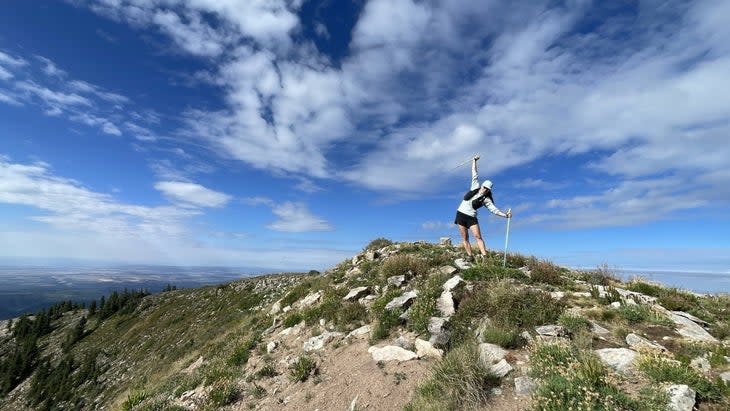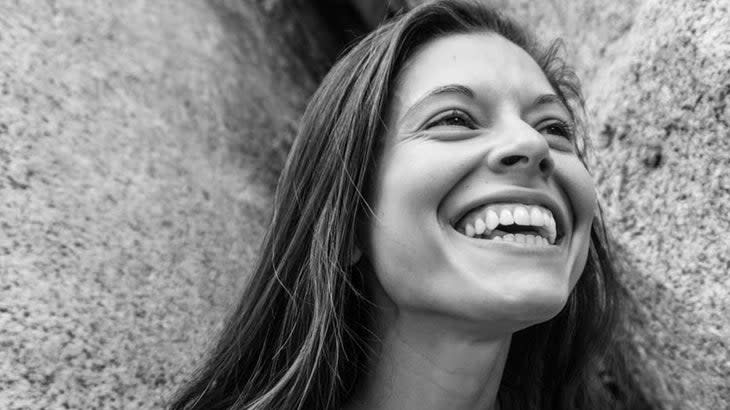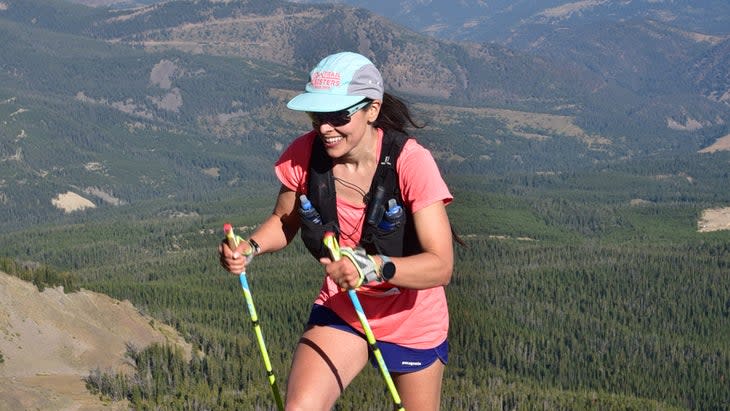Sara Aranda’s Response to Her Breast Cancer Gene Mutation? Collecting FKTs.
This article originally appeared on Outside
In Sara Aranda's Instagram bio, one of her bullet points reads: "BRCA1 mutant."
Along with being an endurance athlete, creative writer, and one of Merrell Test Lab's newest athletes for 2024, Aranda has a known hereditary gene mutation that makes her more likely to develop breast cancer and a handful of other cancers throughout her life. By putting it in her bio and framing it as though she might be a superhero, Aranda is making space for this part of herself that often carries grief and fear, and turning it into a point of connection.
"I want to acknowledge it and hold space for it because that's just the reality of me and my body, but I'm also doing all of this stuff anyway," says Aranda. "I am this person, but I'm also a badass."
On September 27, Aranda tied with Mercedes Siegle-Gaither on a new Fastest Known Time (FKT), from Base to Thunderhead. This accomplishment earned her a spot as a sponsored athlete with Merrell Test Lab for 2024.

'Running Has Seen All of Me'
Based in Durango, Colorado, Aranda, 34, shifted to running trails from road and triathlon while in college at University of California Riverside, to explore the surrounding landscape and cope during a tumultuous time of her life.
When she was 20, her mom passed away from breast cancer. She was grieving, confronting mortality, seeking control, and navigating the soul-searching crises of young adulthood. Now, she lives with her husband, Patrick Hodge, and is a freelance creative nonfiction writer while working part-time at a local climbing gym.
"I had many trail runs where I was angry or crying or confused, or just very emotional. Running has seen all of me," says Aranda. "Now, I've been reaffirming that running can actually be a celebration: celebrating my body, where I am, how I feel, and all I've learned throughout my life so far."
Aranda's mom, Cheryl Aranda, was 38 years old when she was diagnosed with breast cancer. Aranda was 12. "I might not remember all the details," says Aranda. "It was a seven-year period of it being there, in remission, and coming back." Cheryl was predisposed to getting breast cancer because she had the breast cancer 1 (BRCA1) gene mutation--same as Aranda.
About BRCA Gene Mutations
There are two BRCA genes: BRCA1 and BRCA2. While everyone has these genes, only about 1 in 400 people carry an inherited mutation in one of these genes, according to the National Cancer Institute.
Both men and women can carry the BRCA1/2 gene mutations. Reporting from the Susan G. Komen organization shows that women who have the inherited BRCA1 or BRCA2 (the other common breast cancer gene) gene mutation have more than a 60 percent risk of developing breast cancer in their lives. That's compared to a 13 percent risk for women in the general population. Along with an increased risk of breast cancer, those with a BRCA1/2 gene mutation also have increased risk of ovarian cancer, pancreatic cancer, and melanoma.
Because the gene mutation is inherited, Aranda was at risk of having the same mutation as her mom, so at 26, she took a blood test, just to check. Her oncologist gave her the news over the phone--while Aranda was on a road trip with Patrick, then still her boyfriend--that she indeed had the BRCA1 mutation.

"It was a moment where you're suddenly just outside yourself," says Aranda. "We stopped at this little diner off the highway in Idaho and ordered pancakes and just tried to have a quiet moment trying to process. I think it was Patrick's 30th birthday, so it was all mixed in like, 'Oh, happy birthday! Your very serious girlfriend might be dead when she's in her mid-40s.'"
Aranda faced the terrifying thought that she might end up enduring everything she witnessed her mom go through. "You can get lost in that despair," she says. "Acknowledging it is how I deal with it. I focus on how I can nurture joy while holding space for this grief and despair."
Making the Most of the Life We Have
Having seen her mom die at 45, and knowing she has the same BRCA1 gene mutation, Aranda is adamant about living the life she wants in the present. This has included spending several seasons working in Yosemite, testing her limits with a growing list of FKTs, and telling stories through her writing with essays and her monthly "Moonbox Notes."
"She moves through the world as a storyteller," says one of Aranda's ReNewEarthRunning teammates and friend, Becca Jay. "She's always observing and processing things and everything she takes in translates into her writing. I think that's part of why her writing is so beautiful."
Aranda's passion for running and resume of FKTs led her to Merrell's event in Steamboat Springs, competing for her 14th FKT. The route is steep, with approximately 2,200 feet of vertical gain in 3.2 miles. It switchbacks up the mountain, winding along the Thunderhead Trail under tree cover and occasionally crossing the exposed ski slope.
"I really appreciated the shade when you were in the trees," says Aranda. "It wasn't hot, so I felt like I could push harder. Then, you would cross the ski slope and suddenly be exposed to the sun where it was really hot."
Aranda wanted to put everything she could into her effort. Winning this meant more than just a sponsorship for her. It meant the ability to fully pursue her passions for running and writing, something she didn't know how much time she had to do. The sponsorship offers a stable form of income that means she can fully commit to running and writing without the obligation of work in another industry.
Interventions for Survival
A common recommendation for women with BRCA1/2 mutations is to preemptively get a double mastectomy and bilateral salpingo-oophorectomy (surgically removing both breasts, fallopian tubes, and ovaries). These operations can reduce the risk of getting breast or ovarian cancer by 80 to 90 percent. Doctors usually recommend seriously considering these surgeries between 35 and 40, though Aranda's looking at making a decision before 38--when her mom and aunt (who also died of the gene with ovarian cancer) were diagnosed. However, they aren't small operations.
Amber D'Angelo, a swimmer and performance dietician for The Endurance Edge, has the BRCA2 gene mutation and chose to get the preventative surgeries when she found out at age 40, in 2021. "You're thrust into menopause overnight after having your ovaries removed and that changes how you feel," says D'Angelo. "You don't feel quite yourself with the lack of hormones."
RELATED: New Film 'Endure' Follows Cancer Crusader on 200-Mile Run
While the recovery times for the surgeries aren't drastically different from any other major surgery, one of the biggest impacts is going into early menopause. This can cause all the classic menopause symptoms and particularly for athletes, may require more rest and recovery time. For D'Angelo, they were surgeries worth having to take control of her health.
Turning 35 in December, Aranda knows she'll have to make this incredibly personal decision within the next three years. "But a lot can happen in three years, right? Maybe the science wasn't there for my mom and her sister, but it will be for me. You always cross your fingers," says Aranda. "I want to keep the body that I've always known. And the idea of going into medical menopause is terrifying because that brings its own risks like osteoporosis and heart disease. It's like, do I want to risk my chances with cancer or bone and heart issues?"
Tied on the Trail
On the last switchback before the end, Aranda could see everyone at the top watching her ascend. She rounded the corner and avoided looking at anyone's faces, just focusing on pushing herself and touching the gondola pole that marked the finish.
Aranda touched the pole and stopped her watch. 48:41. She'd made it, but she didn't know if she'd won because she didn't know anyone else's time.
"With any race or FKT, you see your time as you cross the finish line, and you know your position, if you did it or not," says Aranda. For this race, each athlete started separately and timed themselves to later upload to the FKT website. "This was so up in the air. You had no idea."

A few minutes went by before someone asked Aranda her time. At that point, she discovered Siegle-Gaither had gotten 48:40.5. At the top of the ski hill, surrounded by yellow aspens, the two compared watch times. According to the watches, Aranda was half a second slower than Siegle-Gaither. However, Aranda's watch didn't track milliseconds, so her watch could have been rounding, and the times could be even closer. It was as close to a tie as you could get for a self-timed FKT, and Merrell hadn't prepared for this possibility.
RELATED: How to Set a Fastest Known Time
"Literally, they tied," says Ben Stark, Merrell senior brand marketing specialist. "Who would have thought that was remotely possible?"
For two days after the tie, the two athletes waited for a decision from the admins at fastestknowntime.com and Merrell. "My head was going everywhere," says Aranda. "I hoped for the best. I hoped that the brand wouldn't split hairs, but I also understood sometimes races have to split hairs."
By Friday, September 28, they had a result: the time variation was within the margin of error of hand-timing, so the site officially recorded it as a tie for a total time of 48:41, and Merrell committed to signing both athletes.
Looking Ahead
Moving into 2024 with the Merrell sponsorship, Aranda hopes to continue nurturing joy in her life, sharing her story, advocating for others, and celebrating her body even when her genetics feel against her at times.
Since her run to Thunderhead, Aranda has already added four new FKTs to her growing list of achievements to accompany her fundraiser for ReNew Earth Running (RER), whose mission is to "protect and heal the environment by restoring land to the stewardship of Tribal Nations and Indigenous leadership."
"I'm curious what [being sponsored] will actually feel like, but I'm excited to have fun with it," says Aranda. "I'm taking it as a chance to explore new avenues, collaborate with new people, and continue to work on the key aspects of myself and how that can be a platform to uplift others."
For Aranda, this was one more step to pursuing her dream life, but in doing so, it also honors her mom's legacy.
"She always encouraged [me and my siblings] to follow our dreams," she says. "She was a musician and dreamed of being a rockstar. Knowing she never got to fulfill her dreams in the fullest of ways, I felt like chasing my dreams was the right path."
For exclusive access to all of our fitness, gear, adventure, and travel stories, plus discounts on trips, events, and gear, sign up for Outside+ today.

